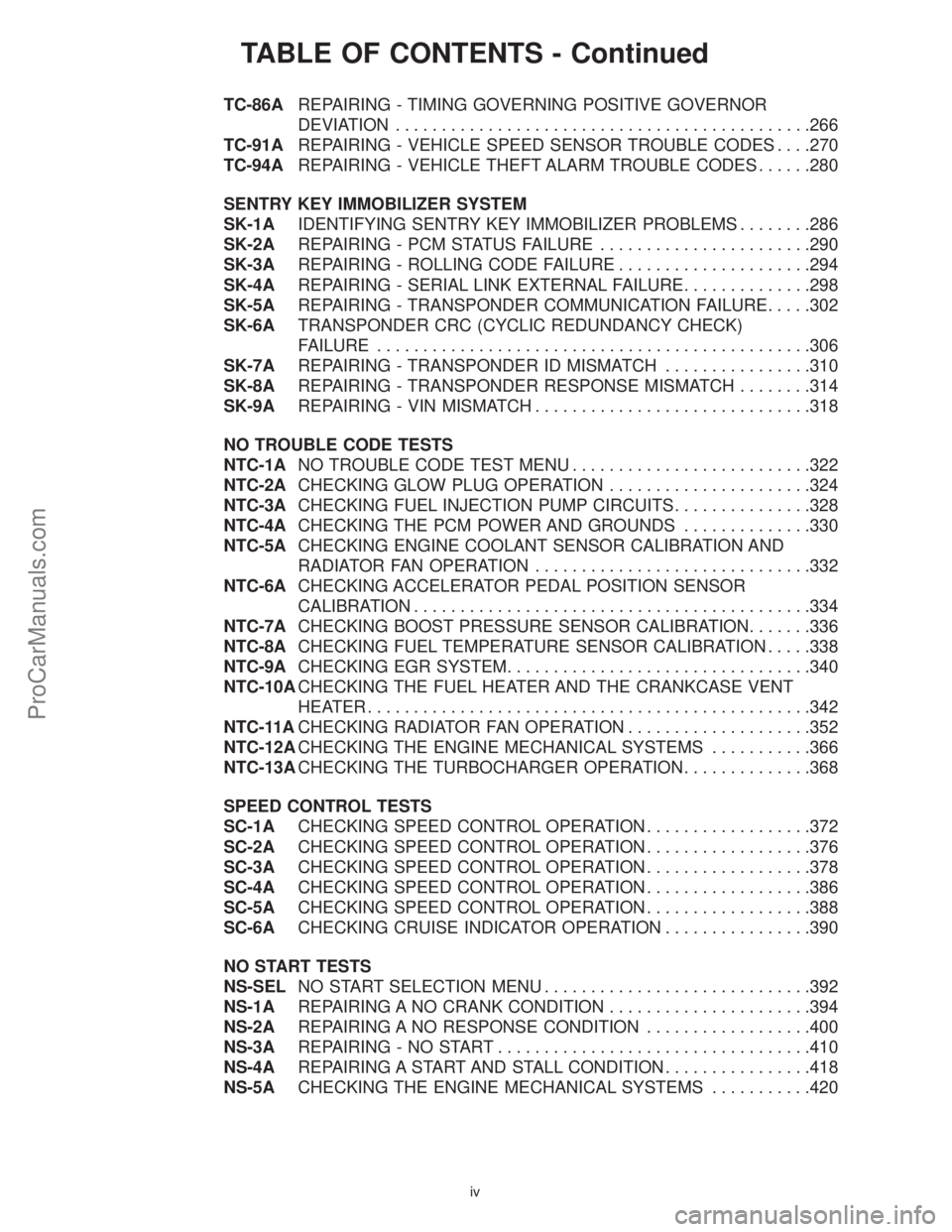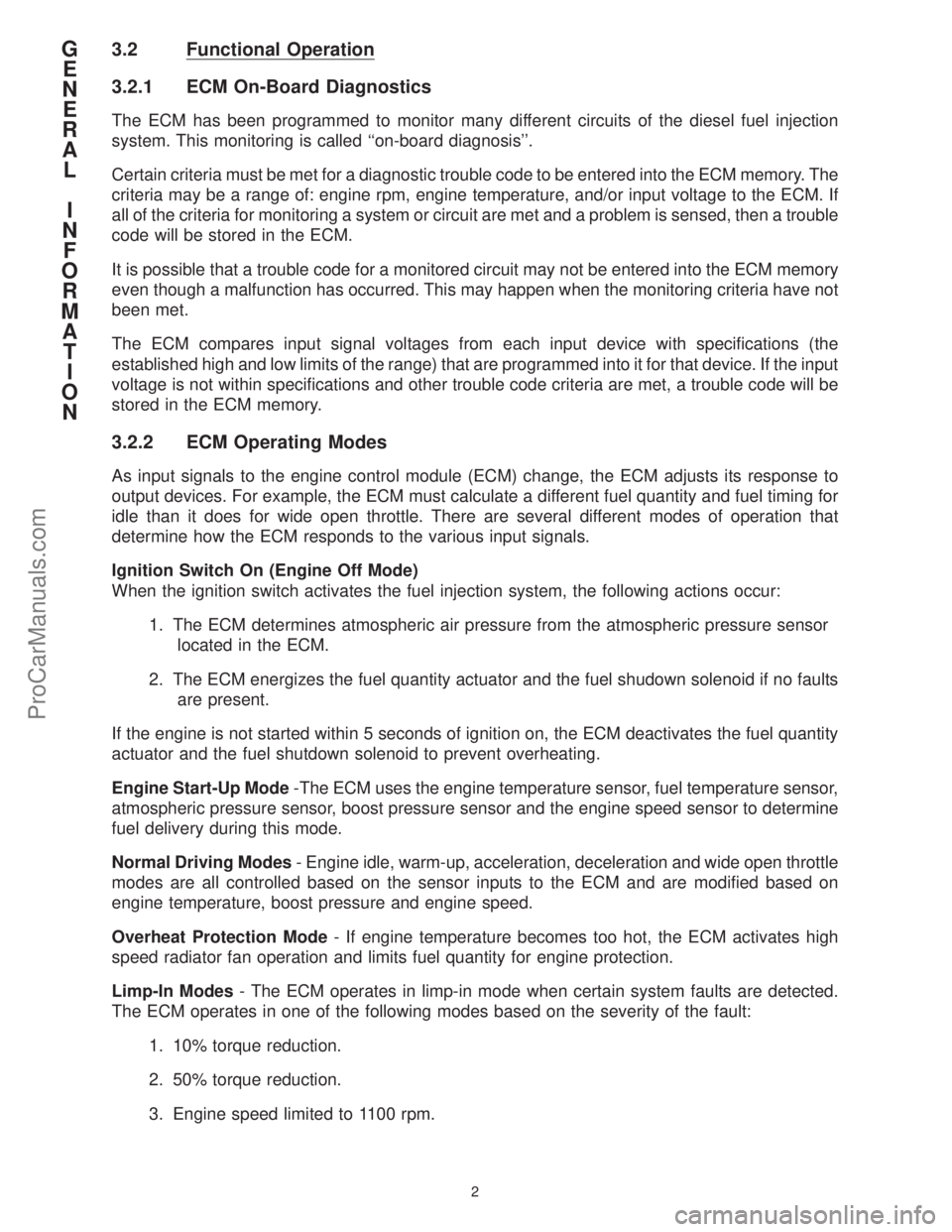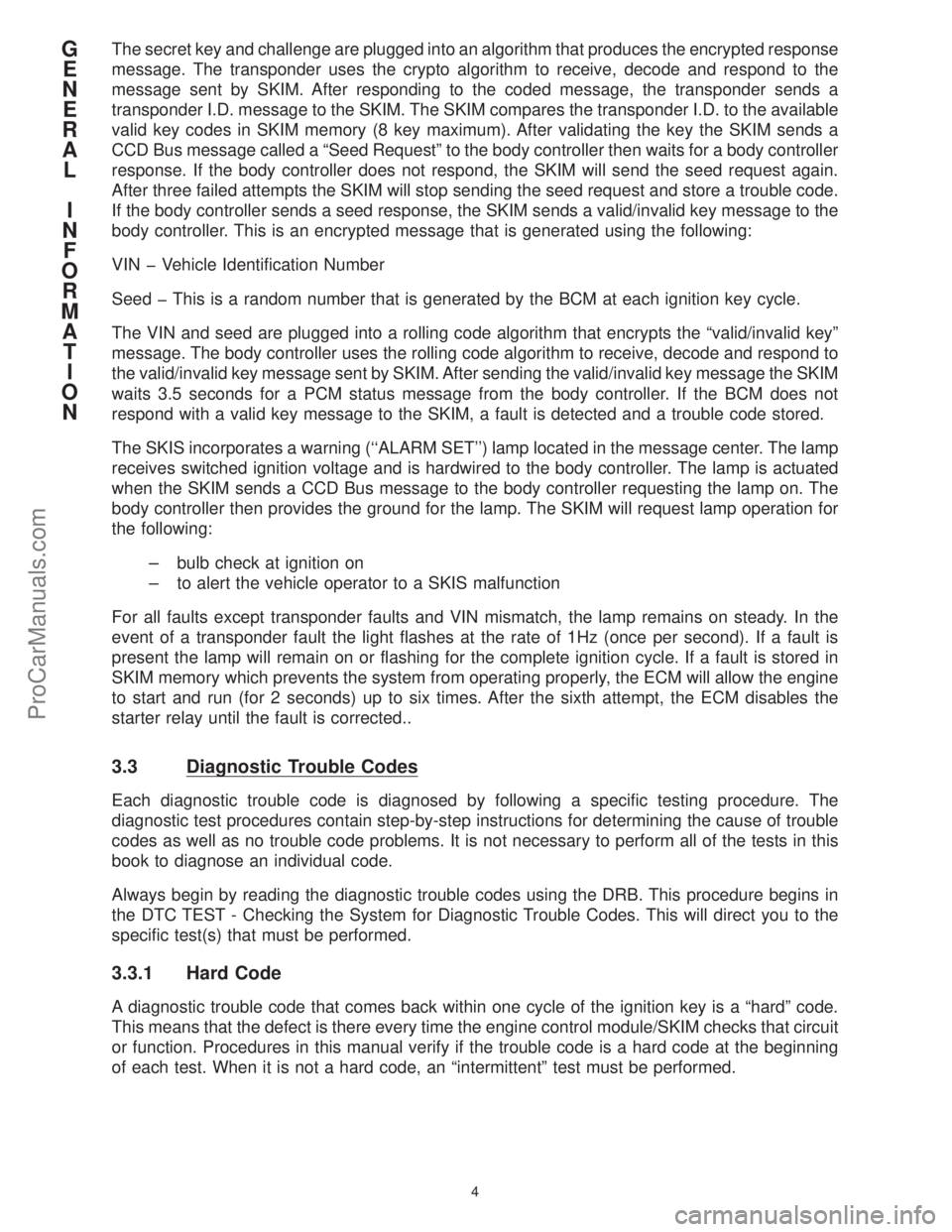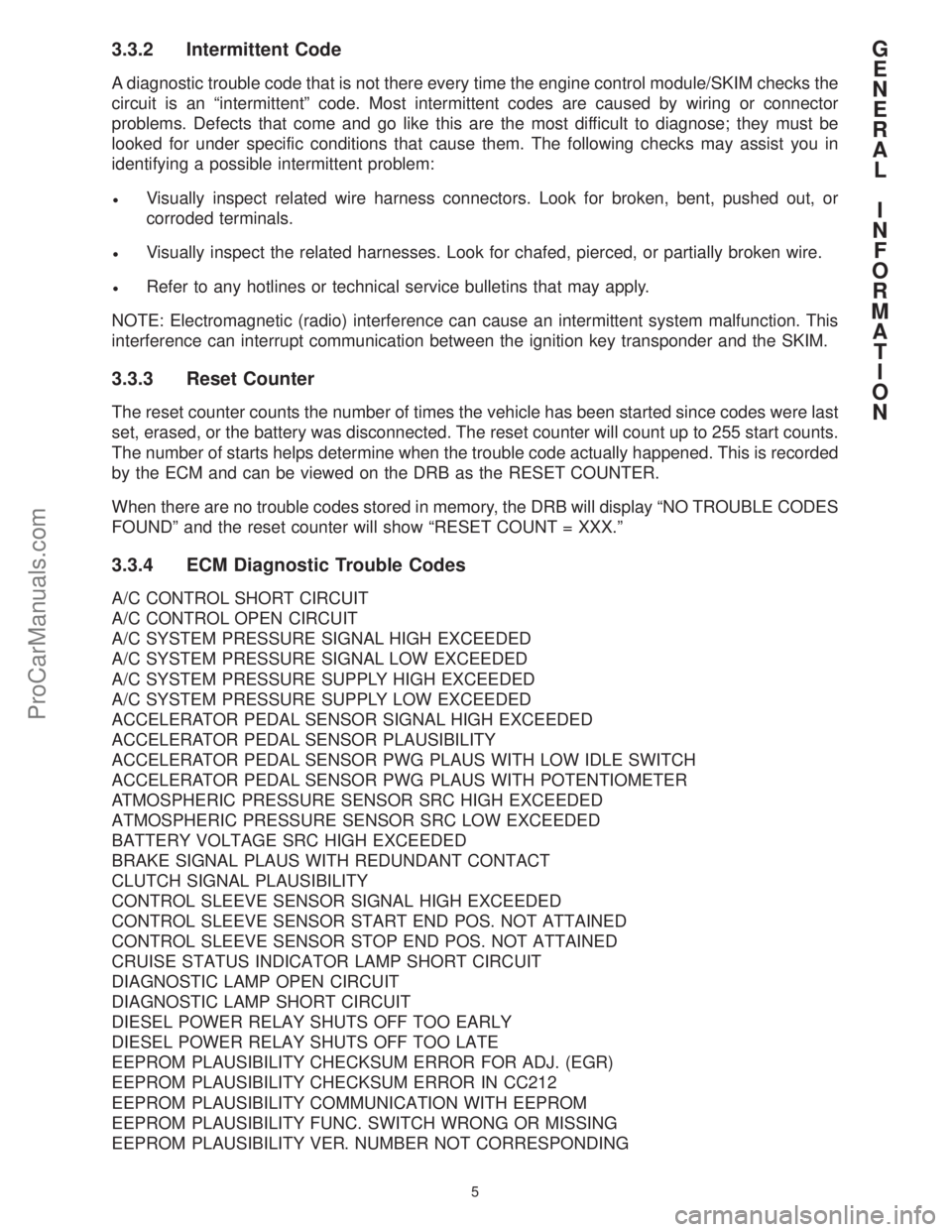ESP CHRYSLER CARAVAN 2000 Service Manual
[x] Cancel search | Manufacturer: CHRYSLER, Model Year: 2000, Model line: CARAVAN, Model: CHRYSLER CARAVAN 2000Pages: 436, PDF Size: 3.4 MB
Page 4 of 436

TABLE OF CONTENTS - Continued
TC-86AREPAIRING - TIMING GOVERNING POSITIVE GOVERNOR
DEVIATION.............................................266
TC-91AREPAIRING - VEHICLE SPEED SENSOR TROUBLE CODES. . . .270
TC-94AREPAIRING - VEHICLE THEFT ALARM TROUBLE CODES......280
SENTRY KEY IMMOBILIZER SYSTEM
SK-1AIDENTIFYING SENTRY KEY IMMOBILIZER PROBLEMS........286
SK-2AREPAIRING - PCM STATUS FAILURE.......................290
SK-3AREPAIRING - ROLLING CODE FAILURE.....................294
SK-4AREPAIRING - SERIAL LINK EXTERNAL FAILURE..............298
SK-5AREPAIRING - TRANSPONDER COMMUNICATION FAILURE.....302
SK-6ATRANSPONDER CRC (CYCLIC REDUNDANCY CHECK)
FAILURE...............................................306
SK-7AREPAIRING - TRANSPONDER ID MISMATCH................310
SK-8AREPAIRING - TRANSPONDER RESPONSE MISMATCH........314
SK-9AREPAIRING - VIN MISMATCH..............................318
NO TROUBLE CODE TESTS
NTC-1ANO TROUBLE CODE TEST MENU..........................322
NTC-2ACHECKING GLOW PLUG OPERATION......................324
NTC-3ACHECKING FUEL INJECTION PUMP CIRCUITS...............328
NTC-4ACHECKING THE PCM POWER AND GROUNDS..............330
NTC-5ACHECKING ENGINE COOLANT SENSOR CALIBRATION AND
RADIATOR FAN OPERATION..............................332
NTC-6ACHECKING ACCELERATOR PEDAL POSITION SENSOR
CALIBRATION...........................................334
NTC-7ACHECKING BOOST PRESSURE SENSOR CALIBRATION.......336
NTC-8ACHECKING FUEL TEMPERATURE SENSOR CALIBRATION.....338
NTC-9ACHECKING EGR SYSTEM.................................340
NTC-10ACHECKING THE FUEL HEATER AND THE CRANKCASE VENT
HEATER................................................342
NTC-11ACHECKING RADIATOR FAN OPERATION....................352
NTC-12ACHECKING THE ENGINE MECHANICAL SYSTEMS...........366
NTC-13ACHECKING THE TURBOCHARGER OPERATION..............368
SPEED CONTROL TESTS
SC-1ACHECKING SPEED CONTROL OPERATION..................372
SC-2ACHECKING SPEED CONTROL OPERATION..................376
SC-3ACHECKING SPEED CONTROL OPERATION..................378
SC-4ACHECKING SPEED CONTROL OPERATION..................386
SC-5ACHECKING SPEED CONTROL OPERATION..................388
SC-6ACHECKING CRUISE INDICATOR OPERATION................390
NO START TESTS
NS-SELNO START SELECTION MENU.............................392
NS-1AREPAIRING A NO CRANK CONDITION......................394
NS-2AREPAIRING A NO RESPONSE CONDITION..................400
NS-3AREPAIRING - NO START..................................410
NS-4AREPAIRING A START AND STALL CONDITION................418
NS-5ACHECKING THE ENGINE MECHANICAL SYSTEMS...........420
iv
ProCarManuals.com
Page 8 of 436

3.2 Functional Operation
3.2.1 ECM On-Board Diagnostics
The ECM has been programmed to monitor many different circuits of the diesel fuel injection
system. This monitoring is called ``on-board diagnosis''.
Certain criteria must be met for a diagnostic trouble code to be entered into the ECM memory. The
criteria may be a range of: engine rpm, engine temperature, and/or input voltage to the ECM. If
all of the criteria for monitoring a system or circuit are met and a problem is sensed, then a trouble
code will be stored in the ECM.
It is possible that a trouble code for a monitored circuit may not be entered into the ECM memory
even though a malfunction has occurred. This may happen when the monitoring criteria have not
been met.
The ECM compares input signal voltages from each input device with specifications (the
established high and low limits of the range) that are programmed into it for that device. If the input
voltage is not within specifications and other trouble code criteria are met, a trouble code will be
stored in the ECM memory.
3.2.2 ECM Operating Modes
As input signals to the engine control module (ECM) change, the ECM adjusts its response to
output devices. For example, the ECM must calculate a different fuel quantity and fuel timing for
idle than it does for wide open throttle. There are several different modes of operation that
determine how the ECM responds to the various input signals.
Ignition Switch On (Engine Off Mode)
When the ignition switch activates the fuel injection system, the following actions occur:
1. The ECM determines atmospheric air pressure from the atmospheric pressure sensor
located in the ECM.
2. The ECM energizes the fuel quantity actuator and the fuel shudown solenoid if no faults
are present.
If the engine is not started within 5 seconds of ignition on, the ECM deactivates the fuel quantity
actuator and the fuel shutdown solenoid to prevent overheating.
Engine Start-Up Mode-The ECM uses the engine temperature sensor, fuel temperature sensor,
atmospheric pressure sensor, boost pressure sensor and the engine speed sensor to determine
fuel delivery during this mode.
Normal Driving Modes- Engine idle, warm-up, acceleration, deceleration and wide open throttle
modes are all controlled based on the sensor inputs to the ECM and are modified based on
engine temperature, boost pressure and engine speed.
Overheat Protection Mode- If engine temperature becomes too hot, the ECM activates high
speed radiator fan operation and limits fuel quantity for engine protection.
Limp-In Modes- The ECM operates in limp-in mode when certain system faults are detected.
The ECM operates in one of the following modes based on the severity of the fault:
1. 10% torque reduction.
2. 50% torque reduction.
3. Engine speed limited to 1100 rpm.
G
E
N
E
R
A
L
I
N
F
O
R
M
A
T
I
O
N
2
ProCarManuals.com
Page 9 of 436

After-Run- When fused ignition switch output is removed from the ECM cavity 47, the ECM
performs a self-diagnostic check in the following order:
1. Electrical shut-off test
2. Fuel quantity actuator test
3. Monitoring module test
4. Voltage regulator test
5. Main relay test (if tests 1-4 pass)
If any of tests 1-4 fail, the fault is stored in memory, and can be retrieved during the next ignition
cycle using the DRB.
3.2.3 Monitored Circuits
The ECM is able to monitor and identify most driveability related trouble conditions. Some circuits
are directly monitored through ECM feedback circuitry. In addition, the ECM monitors the voltage
state of some circuits and compares those states with expected values. Other systems are
monitored indirectly when the ECM conducts a rationality test to identify problems.
Although most subsystems of the powertrain control module are either directly or indirectly
monitored, there may be occasions when diagnostic trouble codes are not immediately identified.
For a trouble code to set, specific conditions must be met and unless these conditions are
encountered, a code will not set.
3.2.4 SKIS On-Board Diagnostics
The SKIS module has been programmed to transmit and monitor many different coded messages
as well as CCD Bus messages. This monitoring is called ``On-Board Diagnosis''.
Certain criteria must be met for a diagnostic trouble code to be entered into the Sentry Key
Immobilizer Module (SKIM) memory. The criteria may be a range of: input voltage, CCD Bus
messages, or coded messages to the SKIM. If all of the criteria for monitoring a circuit or function
are met and a fault is sensed, a diagnostic trouble code will be stored in the SKIM memory.
3.2.5 SKIS Overview
The Sentry Key Immobilizer System (SKIS) is an immobilizer system designed to prevent
unauthorized vehicle operation. The system consists of a Sentry Key Immobilizer Module (SKIM),
ignition key(s) equipped with a transponder chip, engine controller and body controller. When the
ignition switch is turned on, the SKIM interrogates the ignition key. If the ignition key is ªValidº the
SKIM sends a CCD Bus message to the body controller indicating the presence of a valid ignition
key. The BCM then supplies the ECM with a valid immobilizer signal allowing the engine to
continue to operate.
3.2.6 SKIS Operation
When ignition power is supplied to the SKIM, the SKIM performs an internal self-test. After the
self-test is completed, the SKIM energizes the antenna (this activates the transponder chip) and
sends a challenge to the transponder chip. The transponder chip responds to the challenge by
generating an encrypted response message using the following:
Secret Key þ This is an electronically stored value (identification number) that is unique to each
SKIS. The secret key is stored in the SKIM, BCM and all ignition key transponders.
Challenge þ This is a random number that is generated by the SKIM at each ignition key cycle.
G
E
N
E
R
A
L
I
N
F
O
R
M
A
T
I
O
N
3
ProCarManuals.com
Page 10 of 436

The secret key and challenge are plugged into an algorithm that produces the encrypted response
message. The transponder uses the crypto algorithm to receive, decode and respond to the
message sent by SKIM. After responding to the coded message, the transponder sends a
transponder I.D. message to the SKIM. The SKIM compares the transponder I.D. to the available
valid key codes in SKIM memory (8 key maximum). After validating the key the SKIM sends a
CCD Bus message called a ªSeed Requestº to the body controller then waits for a body controller
response. If the body controller does not respond, the SKIM will send the seed request again.
After three failed attempts the SKIM will stop sending the seed request and store a trouble code.
If the body controller sends a seed response, the SKIM sends a valid/invalid key message to the
body controller. This is an encrypted message that is generated using the following:
VIN þ Vehicle Identification Number
Seed þ This is a random number that is generated by the BCM at each ignition key cycle.
The VIN and seed are plugged into a rolling code algorithm that encrypts the ªvalid/invalid keyº
message. The body controller uses the rolling code algorithm to receive, decode and respond to
the valid/invalid key message sent by SKIM. After sending the valid/invalid key message the SKIM
waits 3.5 seconds for a PCM status message from the body controller. If the BCM does not
respond with a valid key message to the SKIM, a fault is detected and a trouble code stored.
The SKIS incorporates a warning (``ALARM SET'') lamp located in the message center. The lamp
receives switched ignition voltage and is hardwired to the body controller. The lamp is actuated
when the SKIM sends a CCD Bus message to the body controller requesting the lamp on. The
body controller then provides the ground for the lamp. The SKIM will request lamp operation for
the following:
± ± bulb check at ignition on
± to alert the vehicle operator to a SKIS malfunction
For all faults except transponder faults and VIN mismatch, the lamp remains on steady. In the
event of a transponder fault the light flashes at the rate of 1Hz (once per second). If a fault is
present the lamp will remain on or flashing for the complete ignition cycle. If a fault is stored in
SKIM memory which prevents the system from operating properly, the ECM will allow the engine
to start and run (for 2 seconds) up to six times. After the sixth attempt, the ECM disables the
starter relay until the fault is corrected..
3.3 Diagnostic Trouble Codes
Each diagnostic trouble code is diagnosed by following a specific testing procedure. The
diagnostic test procedures contain step-by-step instructions for determining the cause of trouble
codes as well as no trouble code problems. It is not necessary to perform all of the tests in this
book to diagnose an individual code.
Always begin by reading the diagnostic trouble codes using the DRB. This procedure begins in
the DTC TEST - Checking the System for Diagnostic Trouble Codes. This will direct you to the
specific test(s) that must be performed.
3.3.1 Hard Code
A diagnostic trouble code that comes back within one cycle of the ignition key is a ªhardº code.
This means that the defect is there every time the engine control module/SKIM checks that circuit
or function. Procedures in this manual verify if the trouble code is a hard code at the beginning
of each test. When it is not a hard code, an ªintermittentº test must be performed.
G
E
N
E
R
A
L
I
N
F
O
R
M
A
T
I
O
N
4
ProCarManuals.com
Page 11 of 436

3.3.2 Intermittent Code
A diagnostic trouble code that is not there every time the engine control module/SKIM checks the
circuit is an ªintermittentº code. Most intermittent codes are caused by wiring or connector
problems. Defects that come and go like this are the most difficult to diagnose; they must be
looked for under specific conditions that cause them. The following checks may assist you in
identifying a possible intermittent problem:
²Visually inspect related wire harness connectors. Look for broken, bent, pushed out, or
corroded terminals.
²Visually inspect the related harnesses. Look for chafed, pierced, or partially broken wire.
²Refer to any hotlines or technical service bulletins that may apply.
NOTE: Electromagnetic (radio) interference can cause an intermittent system malfunction. This
interference can interrupt communication between the ignition key transponder and the SKIM.
3.3.3 Reset Counter
The reset counter counts the number of times the vehicle has been started since codes were last
set, erased, or the battery was disconnected. The reset counter will count up to 255 start counts.
The number of starts helps determine when the trouble code actually happened. This is recorded
by the ECM and can be viewed on the DRB as the RESET COUNTER.
When there are no trouble codes stored in memory, the DRB will display ªNO TROUBLE CODES
FOUNDº and the reset counter will show ªRESET COUNT = XXX.º
3.3.4 ECM Diagnostic Trouble Codes
A/C CONTROL SHORT CIRCUIT
A/C CONTROL OPEN CIRCUIT
A/C SYSTEM PRESSURE SIGNAL HIGH EXCEEDED
A/C SYSTEM PRESSURE SIGNAL LOW EXCEEDED
A/C SYSTEM PRESSURE SUPPLY HIGH EXCEEDED
A/C SYSTEM PRESSURE SUPPLY LOW EXCEEDED
ACCELERATOR PEDAL SENSOR SIGNAL HIGH EXCEEDED
ACCELERATOR PEDAL SENSOR PLAUSIBILITY
ACCELERATOR PEDAL SENSOR PWG PLAUS WITH LOW IDLE SWITCH
ACCELERATOR PEDAL SENSOR PWG PLAUS WITH POTENTIOMETER
ATMOSPHERIC PRESSURE SENSOR SRC HIGH EXCEEDED
ATMOSPHERIC PRESSURE SENSOR SRC LOW EXCEEDED
BATTERY VOLTAGE SRC HIGH EXCEEDED
BRAKE SIGNAL PLAUS WITH REDUNDANT CONTACT
CLUTCH SIGNAL PLAUSIBILITY
CONTROL SLEEVE SENSOR SIGNAL HIGH EXCEEDED
CONTROL SLEEVE SENSOR START END POS. NOT ATTAINED
CONTROL SLEEVE SENSOR STOP END POS. NOT ATTAINED
CRUISE STATUS INDICATOR LAMP SHORT CIRCUIT
DIAGNOSTIC LAMP OPEN CIRCUIT
DIAGNOSTIC LAMP SHORT CIRCUIT
DIESEL POWER RELAY SHUTS OFF TOO EARLY
DIESEL POWER RELAY SHUTS OFF TOO LATE
EEPROM PLAUSIBILITY CHECKSUM ERROR FOR ADJ. (EGR)
EEPROM PLAUSIBILITY CHECKSUM ERROR IN CC212
EEPROM PLAUSIBILITY COMMUNICATION WITH EEPROM
EEPROM PLAUSIBILITY FUNC. SWITCH WRONG OR MISSING
EEPROM PLAUSIBILITY VER. NUMBER NOT CORRESPONDING
G
E
N
E
R
A
L
I
N
F
O
R
M
A
T
I
O
N
5
ProCarManuals.com
Page 13 of 436

3.3.5 SKIM Diagnostic Trouble Codes
ANTENNA FAILURE
COP FAILURE
EEPROM FAILURE
PCM STATUS FAILURE
INTERNAL FAULT
RAM FAILURE
ROLLING CODE FAILURE
SERIAL LINK EXTERNAL FAULT
STACK OVERFLOW FAILURE
TRANSPONDER COMMUNICATION FAILURE
TRANSPONDER CRC (CYCLIC REDUNDANCY CHECK) FAILURE
TRANSPONDER ID MISMATCH
TRANSPONDER RESPONSE MISMATCH
VIN MISMATCH
3.3.6 Handling No Trouble Code Problems
After reading Section 3.0 (System Description and Functional Operation), you should have a
better understanding of the theory and operation of the on-board diagnostics, and how this relates
to the diagnosis of a vehicle that may have a driveability-related symptom or complaint.
The ``no code'' system is broken down into three test methods:
± No Code Complete Test
± No Code Quick Individual Test
± No Code Quick Symptom Test
3.4 Using the DRB
Refer to the DRB user's guide for instructions and assistance with reading trouble codes, erasing
trouble codes, and other DRB functions.
3.5 DRB Error Messages and Blank Screen
Under normal operation, the DRB will display one of only two error messages:
± ± User-Requested WARM Boot or User-Requested COLD Boot
This is a sample of such an error message display:
ver: 2.14
date: 26 Jul93
file: key_itf.cc
date: Jul 26 1993
line 548
err: 0x1
User-Requested COLD Boot
Press MORE to switch between this display
and the application screen.
Press F4 when done noting information.
G
E
N
E
R
A
L
I
N
F
O
R
M
A
T
I
O
N
7
ProCarManuals.com
Page 23 of 436

4.8 Lamps and Indicators
The ªCruiseº lamp is controlled by the Body Control Module. The Diagnostic/Glow Plug lamp is
controlled by the Engine Control Module. The ªAlarm Setº lamp is controlled by the SKIM.
5.0 DISCLAIMERS, SAFETY, WARNINGS
5.1 Disclaimers
All information, illustrations, and specifications contained in this manual are based on the latest
information available at the time of publication. The right is reserved to make changes at any time
without notice.
5.2 Safety
5.2.1 Technician Safety Information
WARNING!!Engines produce carbon monoxide that is odorless, causes slower reaction time,
and can lead to serious injury. When the engine is operating, keep service areas WELL
VENTILATED or attach the vehicle exhaust system to the shop exhaust removal system.
Set the parking brake and block the wheels before testing or repairing the vehicle. It is especially
important to block the wheels on front-wheel drive vehicles; the parking brake does not hold the
drive wheels.
When servicing a vehicle, always wear eye protection, and remove any metal jewelry such as
watchbands or bracelets that might make an inadvertent electrical contact.
When diagnosing a powertrain system problem, it is important to follow approved procedures
where applicable. These procedures can be found in the service manual. Following these
procedures is very important to the safety of individuals performing diagnostic tests.
5.2.2 Vehicle Preparation for Testing
Make sure the vehicle being tested has a fully charged battery. If it does not, false diagnostic
codes or error messages may occur.
5.2.3 Servicing Sub-Assemblies
Some components of the powertrain system are intended to be serviced in assembly only.
Attempting to remove or repair certain system sub-components may result in personal injury
and/or improper system operation. Only those components with approved repair and installation
procedures in the service manual should be serviced.
5.2.4 DRBIIITSafety Information
WARNING: Exceeding the limits of the DRB multimeter is dangerous. It can expose you to
serious or possibly fatal injury. Carefully read and understand the cautions and the
specification limits.
²Follow the vehicle manufacturer's service specifications at all times.
²Do not use the DRB if it has been damaged.
²Do not use the test leads if the insulation is damaged or if metal is exposed.
²To avoid electrical shock, do not touch the test leads, tips, or the circuit being tested.
G
E
N
E
R
A
L
I
N
F
O
R
M
A
T
I
O
N
17
ProCarManuals.com
Page 26 of 436

TEST DTCCHECKING FOR DIAGNOSTIC TROUBLE CODES
NOTE: The battery must be fully charged for any test in this manual.
1. Attempt to start the engine. Crank for up to 10 seconds if necessary.
2. Connect the DRB to the data link connector. Write down the trouble codes that are displayed.
3. If the DRB displays ``No Response'', go toTEST NS-2A.
4. If the DRB screen is blank or has a DRB error message, go toGeneral Information Section
3.5in this manual.
5. Iftrouble code messagesare displayed, refer to the trouble code list below and on the
following page for the appropriate test.
6. If there are no ECM trouble codes displayed, refer to one of the following:
For Immobilizer problems..................................................SK-1A
For Driveability problems.................................................NTC-1A
For No Start problems....................................................NS-1A
For Speed Control problems...............................................SC-1A
NOTE:For all component locations see General Information Section 4.0 in this manual.
DRB DIAGNOSTIC TROUBLE CODE (DTC) DISPLAYEDDIAGNOSTIC
TESTSCAN
TOOL
AC Control Short CircuitTC-1 P1655
A/C Control Open CircuitTC-2 P1655
A/C System Pressure Signal High Exceeded TC-3 P1695
A/C System Pressure Signal Low Exceeded TC-4 P1695
A/C System Pressure Supply High Exceeded TC-5 P1695
A/C System Pressure Supply Low Exceeded TC-6 P1695
Accelerator Pedal Sensor High Exceeded TC-7 P1515
Accelerator Pedal Sensor PlausibilityTC-7 P1515
Accelerator Pedal Sensor Pwg Plaus With Low Idle Switch TC-7 P1515
Accelerator Pedal Sensor Pwg Plaus With Potentiometer TC-7 P1515
Atmospheric Pressure Sensor SRC High Exceeded ** P1105
Atmospheric Pressure Sensor SRC Low Exceeded ** P1105
Battery Voltage SRC High Exceeded TC-14 P1600
Turbocharger Boost Sensor Signal High Exceeded TC-15 P0235
Turbocharger Boost Sensor Signal Low Exceeded TC-16 P0235
Turbocharger Boost Sensor Supply High Exceeded TC-17 P0235
Turbocharger Boost Sensor Supply Low Exceeded TC-18 P0235
Turbocharger Boost Sensor Plausibility TC-19 P0235
Brake Signal Plaus With Redundant Contact TC-20 P1703
Clutch Signal PlausibilityTC-21 P1740
Control Sleeve Sensor Signal High Exceeded TC-22 P1225
Control Sleeve Sensor Start End Pos. Not Attained TC-23 P1225
Control Sleeve Sensor Stop End Pos. Not Attained TC-24 P1225
Cruise Status Indicator Lamp Short Circuit TC-25 P1665
Diagnostic Lamp Open CircuitTC-26 P1650
Diagnostic Lamp Short CircuitTC-27 P1650
Diesel Power Relay Shuts Off Too Early TC-30 P1625
Diesel Power Relay Shuts Off Too Late TC-31 P1625
EEPROM Plausibility Checksum Error For Adj. ** P1680
EEPROM Plausibility Checksum Error in CC212 ** P1680
EEPROM Plausibility Communication with EEPROM ** P1680
EEPROM Plausibility Func. Switch Wrong or Missing ** P1680
EEPROM Plausibility Ver. Number Not Corresponding ** P1680
EGR Open CircuitTC-33 P0400
EGR Short CircuitTC-34 P0400
Engine Speed Sensor Dynamic Plausibility TC-35 P0725
T
R
O
U
B
L
E
C
O
D
E
T
E
S
T
S
20
ProCarManuals.com
Page 59 of 436

TEST TC-7ACONTINUED - REPAIRING - ACCELERATOR PEDAL SENSOR TROUBLE CODES
*Perform Verification TEST VER-2A. **Check connectors - Clean / repair as necessary.
TEST TC-7A FULLY DPRESS THE
CONTINUED FROM THROTTLE. IS THE VOLTAGE NO REPLACE THE
THE PREVIOUS BETWEEN ACCELERATOR PEDAL
PAGE. WITH THE DRB, READ 4.1 AND 4.6 VOLTS? POSITION SENSOR.*
ACCEL PEDAL VOLTS.
YES
USING AN ANALOG SLOWLY DEPRESS AND
VOLTMETER, BACKPROBE RELEASE THE
ACCEL PEDAL SENSOR ACCELERATOR PEDAL
HARNESS CONN SEVERAL TIMES WHILE
CAVITY 7. FIG.1 OBSERVING THE METER.
NOTE: THE WITHOUT ANY SHARP DOES VOLTAGE
VOLTMETER NEEDLE INCREASE OR INCREASE AND NO REPLACE THE
SHOULD RESPOND DECREASE IN DECREASE SMOOTHLY ACCELERATOR PEDAL
SMOOTHLY TO ACCEL VOLTAGE. WITH ACCEL PEDAL POSITION SENSOR.*
PEDAL TRAVEL... TRAVEL?
YES
USING THE DRB WITH THE ACCEL PEDAL
CUSTOM DISPLAY, AND THE LOW IDLE AT FULL REST (IDLE) THE ACCEL PEDAL %
OBSERVE THE ACCEL SWITCH INPUT. SLOWLY DEPRESS THE AND THE LOW IDLE
PEDAL SENSOR ACCEL PEDAL WHILE SWITCH INPUT.
PERCENTAGE (%)... OBSERVING...
NOTE: THE LOW IDLE DID LOW IDLE
SWITCH INPUT BETWEEN 8% AND 21% SWITCH INPUT NO REPLACE THE
SHOULD SWITCH FROM OF ACCEL PEDAL CHANGE BETWEEN 8% ACCELERATORE PEDAL
"IDLE" TO POSITION TRAVEL. AND 21% OF ACCEL POSITION SENSOR
"ABOVE IDLE"... PEDAL TRAVEL?
YES
KEY OFF. INSPECT CONNECTOR
DISCONNECT ACCEL FOR DAMAGE, WERE ANY OF THESE YES REPAIR AS
PEDAL SENSOR AND CORROSION, CONDITIONS NECESSARY.*
ECM HARNESS TERMINAL PUSH-OUT PRESENT?
CONNECTORS. OR OTHER PROBLEMS.
NO
RECONNECT ALL WIGGLE THE WIRING REPAIR AS
CONNECTORS. AND CONNECTORS DOES THE DRB YES NECESSARY WHERE
KEY ON. ASSOCIATED WITH THE DISPLAY THIS CODE? WIGGLING CAUSED
USING THE DRB, CLEAR ACCEL PEDAL SENSOR. TROUBLE CODE TO
TROUBLE CODES. CHECK TROUBLE CODES. SET.
NO
CONTINUE TEST
TC-7A ON THE
NEXT PAGE.
T
R
O
U
B
L
E
C
O
D
E
T
E
S
T
S
53
ProCarManuals.com
Page 293 of 436

TEST SK-1AIDENTIFYING SENTRY KEY IMMOBILIZER SYSTEM PROBLEMS
NOTE:The Sentry Key Immobilizer System (SKIS) diagnosis may require usage of the customer's
additional keys to verify the cause of the system failure. In the event that the Sentry Key Immobilizer
Module (SKIM) needs replacing, all of the keys previously programmed into the SKIM's memory
must be programmed into the new SKIM.THEREFORE IT IS IMPORTANT THAT ALL OF THE
CUSTOMER'S KEYS PROGRAMMED FOR THE VEHICLE BE OBTAINED PRIOR TO BEGIN-
NING VEHICLE DIAGNOSIS.
NOTE:It is necessary to obtain the four-digit Personal Identification Number (PIN) from the
customer or the vehicle invoice. The PIN is required to perform certain SKIM tasks using the DRB.
NOTE:It is very important that the ECM/BCM is programmed with the correct Vehicle Identification
Number (VIN). Incorrect VIN programming may result in incorrect diagnosis and unnecessary
component replacement. Use the DRB to verify the correct VIN and country code are programmed
into the SKIM.
1. The battery must be fully charged for any test in this manual.
2. Attempt to start the engine. Crank for up to 10 seconds if necessary.
3. Connect the DRB to the diagnostic connector and select ``Theft Alarm'' then ``SKIM''.
If the DRB displays ``No Response''..................................perform test 1B
NOTE:If the DRB screen is blank or has a DRB error message displayed, go toGeneral
Information Section 3.5in this manual.
4. With the DRB, read and record SKIM trouble codes.
5. If diagnostic trouble code are displayed, refer to the diagnostic trouble code list on the next page
for the appropriate test.
NOTE:For all component locations, seeGeneral Information Section 4.0in this manual.
DIAGNOSTIC TROUBLE CODE (DTC) DISPLAYED
DIAGNOSTIC TEST
ANTENNA FAILURE**
COP FAILURE**
EEPROM FAILURE**
PCM STATUS FAILURE SK-2A
INTERNAL FAULT**
RAM FAILURE**
ROLLING CODE FAILURE SK-3A
SERIAL LINK EXTERNAL FAULT SK-4A
STACK OVERFLOW FAILURE **
TRANSPONDER COMMUNICATION FAILURE SK-5A
TRANSPONDER CRC (CYCLIC REDUNDANCY CHECK)
FAILURESK-6A
TRANSPONDER ID MISMATCH SK-7A
TRANSPONDER RESPONSE MISMATCH SK-8A
VIN MISMATCHSK-9A
**These trouble codes indicate an internal SKIM fault. Using the DRB, clear SKIM trouble code(s).
Perform several key cycles, leaving the key on for a minimum of 30 seconds per cycle. Using the
DRB, read SKIM trouble codes. If the trouble code is present, replace the SKIM.
NOTE:An intermittent start and stall condition accompanied with a transponder DTC can be caused
by the presence of a non-programmed key or key programmed to another vehicle, near the SKIM
antenna (ignition halo). This can occur if the customer has a key holder (ring) that contains more
than one key equipped with a transponder chip.
After replacement of the Sentry Key Immobilizer Module (SKIM) seeGeneral Information Section 8.0
for SKIM initialization.
S
E
N
T
R
Y
K
E
Y
I
M
M
O
B
I
L
I
Z
E
R
S
Y
S
T
E
M
287
ProCarManuals.com